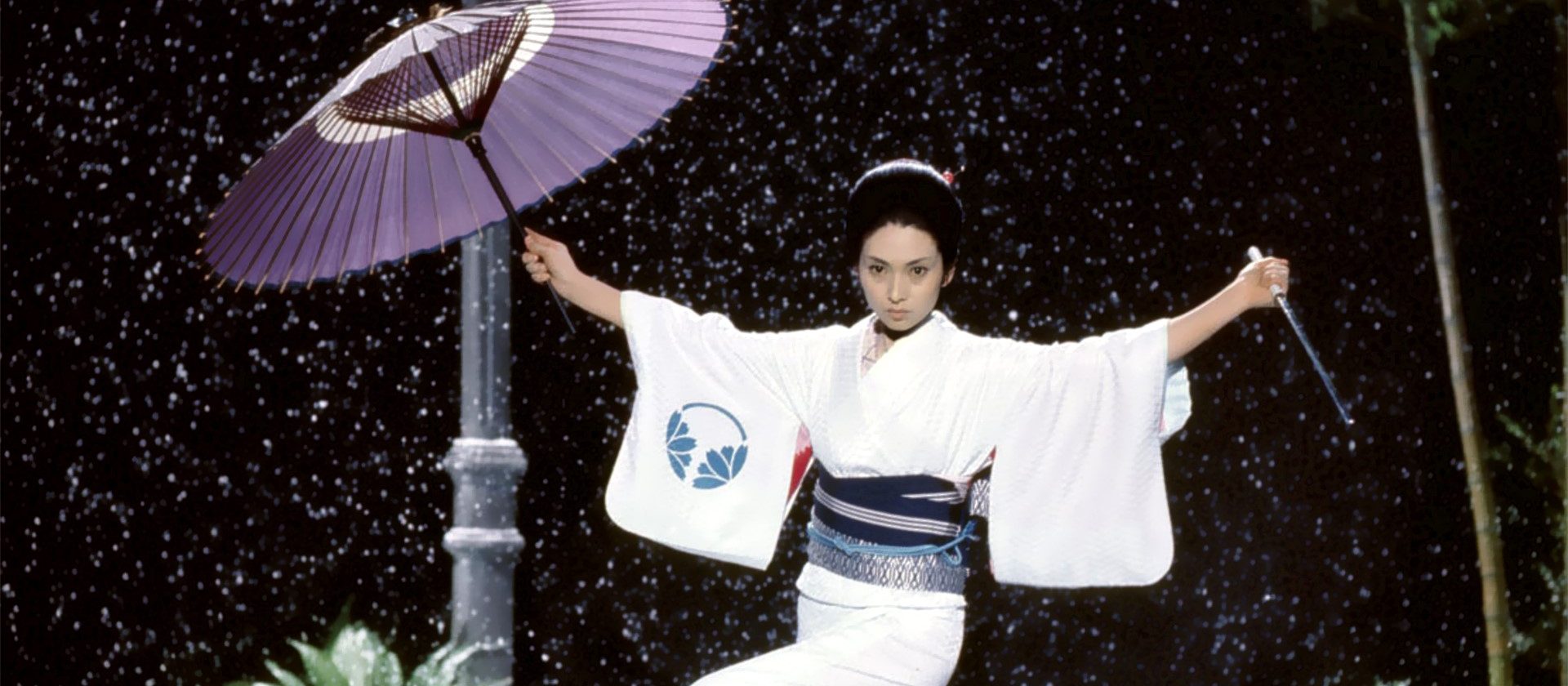
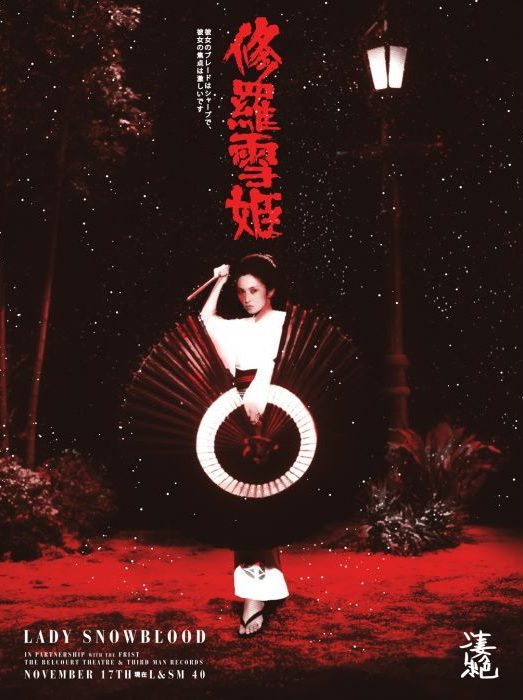
“You were born under unlucky stars.”
Deemed a child of the netherworld at birth—an asura, a demon—orphaned Yuki Kashimi (Meiko Kaji) grows up to be vengeance incarnate. Inherinting the personal vendetta of a mother who died in childbirth, her single-minded purpose in life is to violently redeem the murder of her father and brother and the rape of her mother at the hands of five ruthless tormentors. Based on the violent pulp manga by Kazuo Koike, Lady Snowblood chronicles Yuki’s pursuit and gory slayings of the criminals that destroyed her family; a quest that is satisfying in its fulfillment and yet ultimately tragic as it reduces our heroine to a mere vessel of wrath with no life of her own. Transcending the exploitative roots of the source material, director Toshiya Fujita craftily elevates the story with poetic ultraviolence, expressionistic cinematography, and bold storytelling methods. A strong influence on Tarantino’s Kill Bill Vol. 1, Fujita’s creative odyssey remains an idiosyncratic grindhouse classic.
The film opens with Yuki’s birth on a cot in a crowded Tokyo jail cell in 1874. As she gradually succumbs to death next to her crying newborn, Sayo (Miyoko Akaza) confides in her midwives and cellmates her harrowing tale of murder and rape (shown in one brief, provocatively bloody flashback). Imprisoned for killing one of her rapists, Sayo steeled herself to sleep with as many prison guards as possible in order to conceive a child of vengeance—her wrath incarnate, the pale and savage Shurayuki-hime. (I played around with various translators and the phrase approximates something like “massacre snow princess” or “carnage snow princess.” Or Lady Snowblood.)
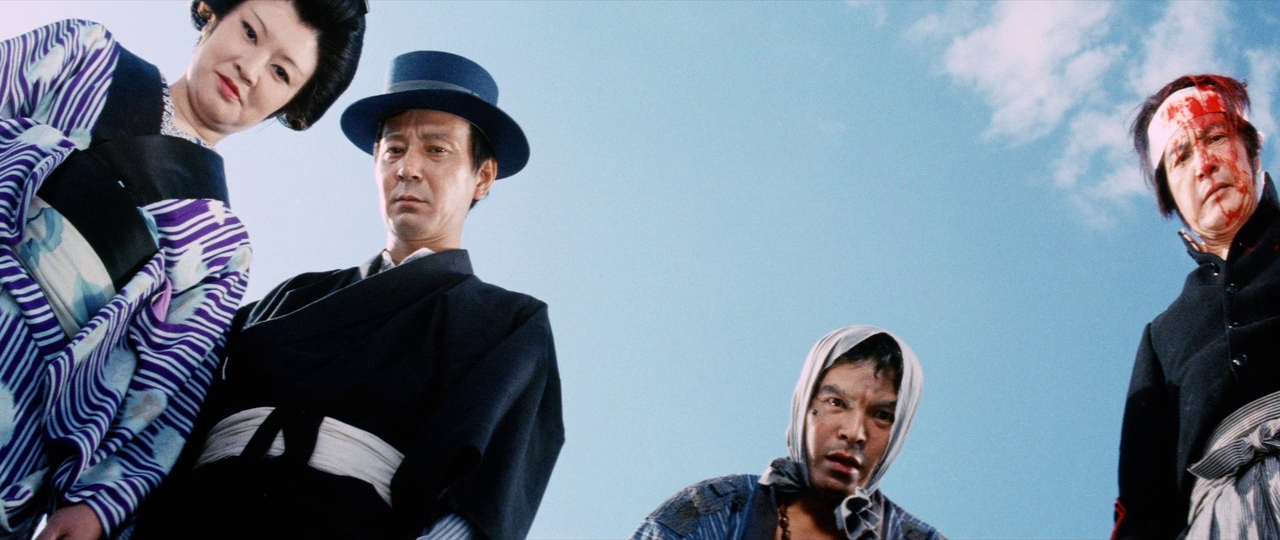
The juxtaposition between Sayo’s flowing crimson robes and the pure white of the snow squall raging outside the penitentiary establishes a bold color scheme that is carried forward as Fujita cuts to the adult Yuki tracking down her first target. Fleet of foot and swift of blade, wandering of her own accord like a rōnin or a lone drifter in a Spaghetti Western, Yuki sports a demure white kimono accented with red and twirls a purple oil-paper umbrella. Her attire makes for a stunning visual that is amplified even further as she sneaks through the gentle snowfall, holds up a rickshaw, then pulls a sword from the parasol’s handle and paints the snow scarlet with acrobatic swordplay. I don’t want to lay it down as a general rule of thumb, but any movie in which a female assassin front flips and chops off a man’s arm within the first five minutes has gotta be good, right?
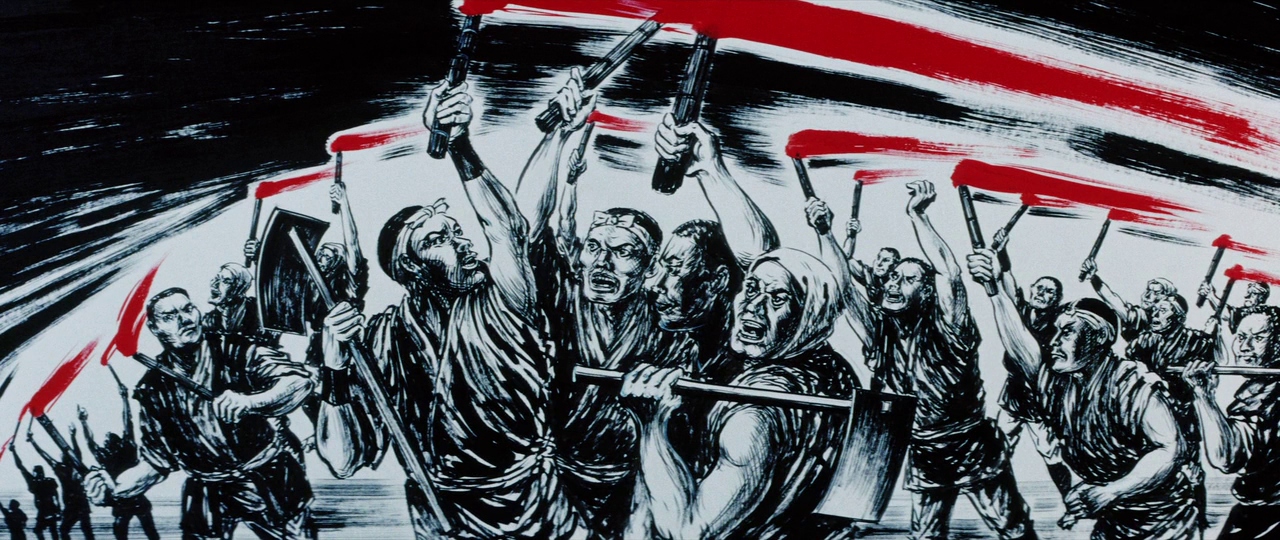
Fujita’s film is broken into four chapters bearing fantastic titles like “Bamboo Wives and Tears of Wrath” and “Crying Bamboo Dolls of the Netherworld” that are heavy with rich flashbacks and brilliantly staged spectacle. One flashback shows a young Yuki (Mayumi Maemura) training under the tutelage of a warrior priest named Dōkai (Kō Nishimura).
An orienting backstory, conveyed using still illustrations that acknowledge the source material, details the onset of the Meiji era in which Japan opened itself up to trade with the West, causing social unrest as the country became stuck between its feudalist past and its imperialist future. Government overreach leads to a swell in the criminal class and the gang that destroys Yuki’s family runs a scam tricking peasants into paying them to avoid a new draft law. The leader, Gishiro Tsukamoto (Eiji Okada), ascends the ranks of the Westernized Meiji government. Thus, Yuki’s pursuit of her family’s tormentors represents more than karmic justice; it also orients Yuki as a sort of Robin Hood figure fighting for the destitute, the downtrodden, the exploited, the common folk. So, Robin Hood mixed with the Grim Reaper.
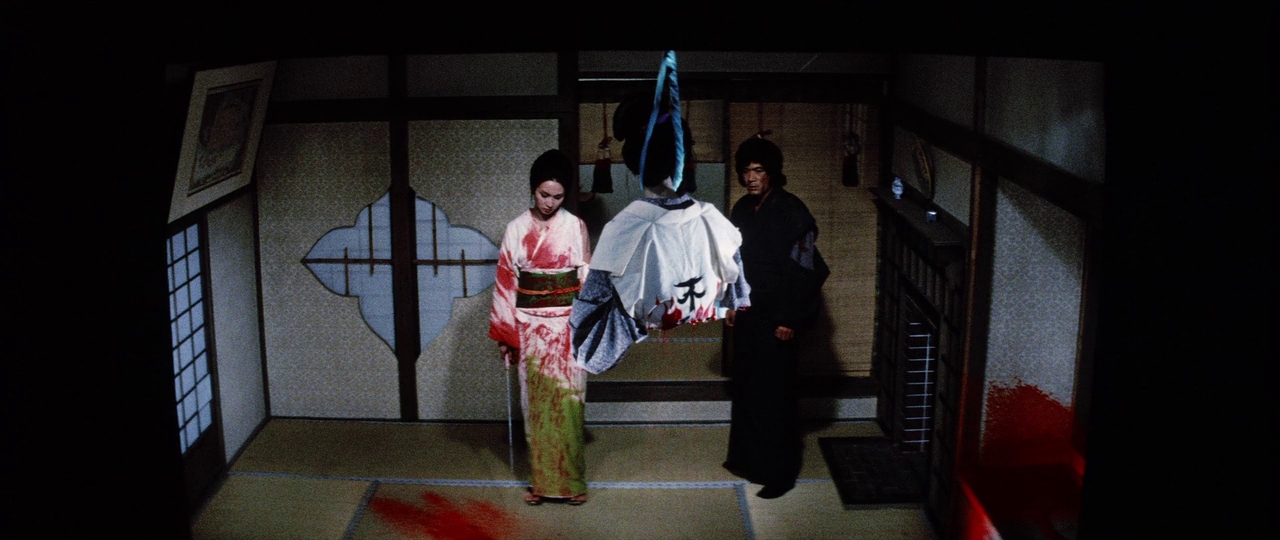
Though the assassin’s lifelong quest for vengeance consumes her every thought and fiber of being, Yuki’s mission is complicated by the presence of two people: a sympathetic journalist named Ashio (Toshio Kurosawa) and a teenage prostitute named Kobue (Yoshiko Nakada) who is working to repay the gambling debts of her alcoholic father, who happens to be on Yuki’s hit list. Thankfully, Fujita never lets his various diversions detract from the headlong rush of his revenge tale.
Nor are its morals ever up for debate. For every crafty scheme to draw out additional targets, there’s a scene in which Yuki lops off limbs and blood spurts and sprays all over the cast and mise en scène. Two of these grisly moments in particular really seared themselves into my brain, occurring in very quick succession. After tracking down Okono (Sanae Nakahara), her mother’s only female tormentor, Yuki discovers the woman has hanged herself to avoid Yuki’s blade. Leaning close, she hears the woman’s dying heartbeat and promptly cuts her in half at the waist, leaving her torso swinging gently from the ceiling. Soon after, she discovers that Gishiro, whose tombstone she had desecrated, is actually alive. He had faked his own death to avoid her wrath. She initially dispatches a double—saving the more spectacular death for Gishiro himself—but it is the double who has both of his hands sliced off in one fell swoop, his fingers still clutching his sword as his hands are flung along with the weapon as a single bleeding mass that crashes into a candelabra.
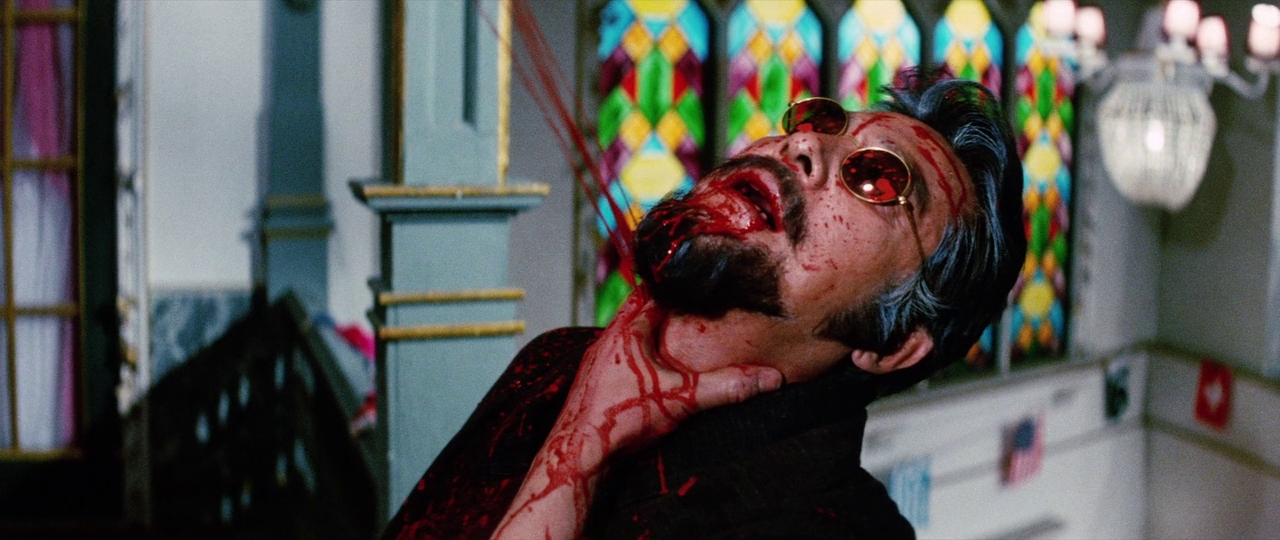
Certainly less blatant but perhaps more interesting than the ample blood-letting are Fujita’s myriad stylistic flourishes. I’ve already mentioned the use of static paintings; but also consider the use of hazy photographs in other flashbacks. Or Fujita’s variation of camera placement—hidden behind subjects, overhead, canted, zooming in and out whimsically, crane shots, handheld; he’s going bananas here—which mixes things up visually but always makes room for carefully composed images of eye-popping carnage.
The inconsistency of the camerawork is seldom distracting, per se. Rather, it gives the film an unpredictable edge that subtly compensates for the lack of complexity in the narrative. The editing, too, dances around erratically, with brief flashes of memory often spliced into the middle of Yuki’s sword fights. Even the sound is manipulated, with an occasional echo effect added as the image drifts out of focus to produce a dreamlike quality. Considering the film’s obvious budget constraints, the achievement of these numerous creative decisions is remarkable.
The morning has died,
And the snow falls in mourning.
A stray dog howls,
And her geta clatter beneath her feet.
She bears the weight of karma,
As she walks gazing straight ahead.
Embracing the darkness with her umbrella-sword,
She walks the path dividing life and death.
If these vengeful themes and wild aesthetic choices seem familiar, well, they should if you’ve been any bit invested in American cinema of the past couple of decades. Quentin Tarantino’s saving grace is that he doesn’t deny his blatant theft from his antecedents. Quite the contrary. He proudly boasts of his pilfering of old genre pictures. In the case of Lady Snowblood, he shamelessly borrows from it across the board for Kill Bill Vol. 1. The tale of revenge for brutal sexual assault, the narrative breakdown into chapters, the use of black-and-white footage and animated stills for flashback segments, the freeze frame introductions of the villains, the heavy use of close-ups and voiceover, the bright red blood against the pure white snow—these elements describe one as much as the other. Tarantino even lifts the main theme of Lady Snowblood, ‘The Flower of Carnage’ for the end credits.
With one foot each in the arthouse and the grindhouse, Lady Snowblood boasts a basic story of swordplay and karmic revenge and all the dismemberment, disembowelment, and bright red gore that those elements imply; couched inside of a subtly experimental cinematic enterprise that interlaces mythology, painterly visual compositions, an elastic narrative, and creatively rendered political commentary. I can understand why Tarantino is a fan.